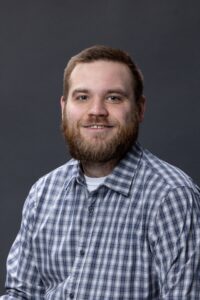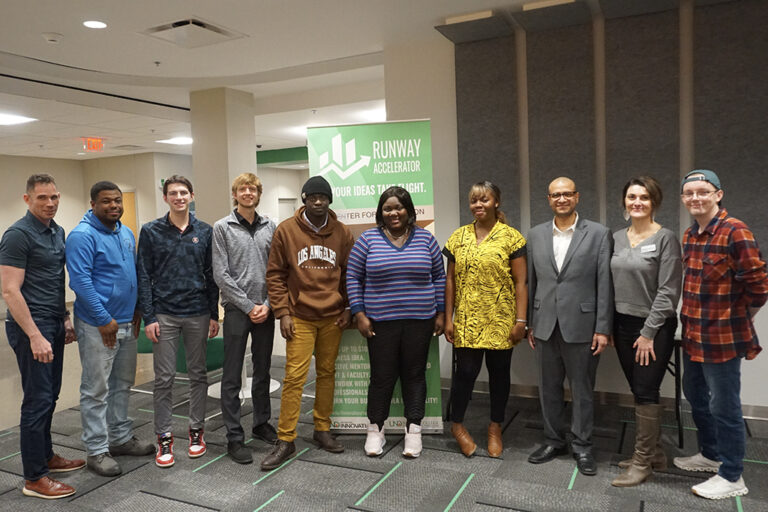Bridging gaps in health knowledge through local news
UND medical students write newspaper articles to reach rural communities

Health care is filled with complicated, hard-to-broach conversations. From colon-cancer screenings to opioid addiction, medical topics can be difficult to talk about and navigate. UND’s Center for Rural Health is trying to start public discussions about these topics and more by introducing them through one of the oldest venues for public discourse: the local newspaper.
The Targeted Rural Health Education project, a joint effort by the UND Center for Rural Health, the UND Department of Family and Community Medicine and the North Dakota Rural Health Association, has connected medical students practicing in rural areas with editors and publishers since 2017. Since its inception, it’s gained the attention and admiration of health professionals across the region.
In June, the Centers for Medicare and Medicaid Health Equity Conference selected The Center for Rural Health to present on TRHE and its benefits, as well as record a StoryCorps conversation about the program.
Over six years, the program has facilitated the publication of 48 articles written by medical students for rural newspapers. The articles’ purpose is to promote health literacy in rural areas and strengthen the connection between rural areas and their medical professionals.
Dr. Kay Miller Temple, web writer at the Center for Rural Health and writing mentor for TRHE, finds that the core intent of the program aligned well with her values in health care.
Miller Temple grew up on a farm and practiced medicine for a number of years before taking on her current role.
“My first language is not medical jargon, my first language is the language of the farm girl,” she said. “So when I was practicing in a clinical role, I found that people were most receptive when I communicated plainly.
“I try to teach these students that you don’t know how much power you have until you meet patients where they’re at. You can be the most brilliant doctor in the world, but there’s always a disconnect until you learn to speak plainly with your patients.”

Increasing health literacy is the primary goal of TRHE. The term refers to the access to and understanding of essential physical and mental health information and is a crucial measure of equity in health care. However, rural communities often face neglect in this respect.
To increase health literacy, the TRHE program provides articles written by medical students directly to local newspapers in the communities the students are living and working in.
“Rural newspapers are huge drivers of information in their communities,” said Stacy Kusler, workforce specialist at the Center for Rural Health. “Yes, people still get information online, but many of the people in these communities want to hear what’s going on right where they’re living.”
Kusler is the project coordinator for TRHE, where she facilitates the publication process, from initial introductions to printing articles.
“I work with rural newspapers in the state to connect them to a completed article. I’ve established good relationships with the communities where we have the students training the most,” she said.
“I’m able to connect students with editors and publishers, explain the project and reassure them that they’ll be receiving something fresh, relevant and newspaper-ready without a ton of editing. That’s all due to the hard work of Kay and the students.”
Further, Kusler explained that establishing a relationship between physicians and newspapers has a positive effect on a community’s health.
“The partnership between health care professionals and rural newspapers is really important. Instead of waiting for a patient to come into the hospital or clinic, sharing information this way can have immediate positive effects on community health,” she said. “I also think that it helps to build a connection of trust and loyalty between the general public and this vital part of their community.”
One of the most vital steps in the process is ensuring that the final article reflects the needs of its audience. To accomplish this, Kusler, Miller Temple and the students look at each community’s Community Health Needs Assessment, allowing them to zero in on a topic that interests the student while remaining relevant.
“Nationally, all hospitals are required to do a Community Health Needs Assessment, and there’s a section in the publication of it that identifies the top health needs of the community,” Kusler explained. “We have the student start from that list and brainstorm possible articles that are publishable and interest them. We really leave it open to the students because that’s how we get the best articles.”

Mitch Gullickson, a third-year medical student at UND who’s currently completing rotations in Fargo, said he chose to write about managing mental health crises because he saw a need for more discourse on the topic. Additionally, it allowed him to understand better how to communicate issues like this to his patients.
“I think in medicine, 90 percent of your communication is going to be with your patients. That’s why participating in this program was great, as it allowed me to develop skills that helped me better communicate with the general public.”
Gullickson spent eight weeks writing his article while he was in Mayville. On the process of working with Temple Miller, Gullickson said it was instructive to him as a writer and health practitioner.
“The process took me about three drafts, start to finish. The first one I submitted had a lot of jargon that I’d been learning in medical school. Throughout the revisions, I found that my drafts were continuously improving, and I was learning more about how I could effectively communicate with patients,” said Gullickson.
Students participating in TRHE generally fall under one of two categories: those who participate in the program electively while working in rural areas, and students who complete it as a mandatory part of the UND Department of Family and Community Medicine’s Rural Opportunities in Medical Education experience.
Second-year student Abigail Smith, whose involvement in ROME had her working for several months in a clinic in Ortonville, Minn., said she took the opportunity to write about something she had long been interested in.
“My undergraduate degree was in neuroscience, so traumatic brain injuries and concussions were something I was already interested in,” she said. “It’s something that I think everyone should understand, so going through the process with Kay, learning how to use simpler words and write in a more approachable way was really valuable to me.”
Smith said that Miller Temple’s emphasis on plain language didn’t come naturally at first, but that the process was valuable.

“It was difficult in the sense that it’s completely different from the analytical writing we’re trained to do through our undergraduate and graduate education. It was hard to alter my writing to be ready for a broader population, but it’s really important to know how to deliver adequate and true information in a way that everyone can understand,” she concluded.
On the other hand, Logan Schmaltz, who is currently completing her residency in Fargo, decided to participate in TRHE electively while living in Devils Lake.
She had developed an interest in rural health after teaching a Medical College Admission Test prep course for INMED, UND’s Indians into Medicine program, which brought her on a field trip to Belcourt, N.D. She said that the visit showed her there was a need for doctors in rural parts of North Dakota.
“It’s very different from more urban areas like Grand Forks and Fargo,” she said. “The resources are limited, the equipment is limited, and specialty care is harder for patients to access. So, I ended up becoming really interested in Native American and rural health, in part, because the health disparities can be so great.”
Schmaltz said that participating in TRHE gave her a more well-rounded view of the state of rural health care and broadened her view of the factors that impact it.
“It definitely changes your perspective, it makes you reconsider some of your prejudices and see how some of these patients are thinking about health care,” she said. “It might not have anything to do with the individual and how they’re taking care of themselves; sometimes, it’s just an issue of access to information and care.”

Schmaltz chose to write about epigenetics, the study of environmental and behavioral effects on genes, which she said aligned with her growing interest in Native American health care. The freedom to pursue a topic was a major selling point to her in participating in the program.
“This program provides you an opportunity to do your own research, talk to people and formulate an essay that hopefully everyone can understand. It just helps to think about medicine in a different way than you would learning from a textbook,” said Schmaltz.
“This is a perfect project because it gets these students so engaged with their community. It makes it meaningful for readers once the article is published,” said Miller Temple. “It starts the conversation, which is really what this is about.”
A full list of TRHE articles can be found on the North Dakota Rural Health Association’s webpage.



